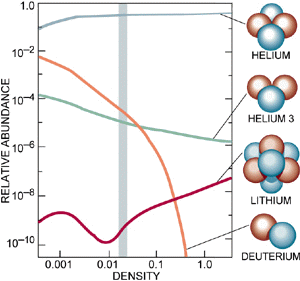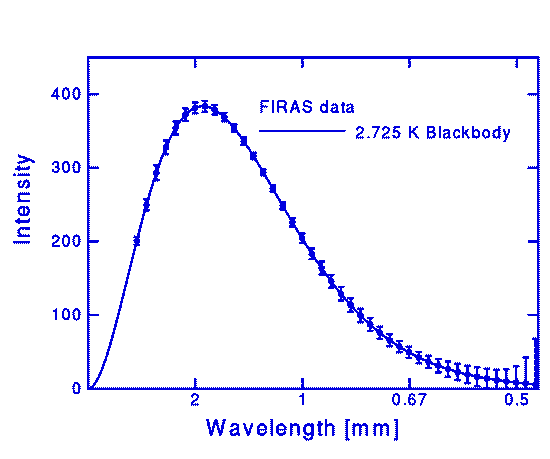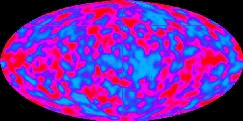

| Gene Smith's Astronomy Tutorial |
 |

The Big Bang
Hubble's Velocity-Distance relationship
established that the
Universe is
expanding. Edwin Hubble made a plot of recession velocity vs distance
for galaxies that he had observed he found a straight line relationship.
The slope of this line, known as the Hubble Parameter, H
 20 (km/s)/million l.y., has units of 1/time. It is easy to see that, if the
Universe is expanding at the present time, then at some point in the past,
all matter was once together. Thus, 1/H, called the Hubble Time is an
estimate of the Age of
the Universe, about 15 billion years.
20 (km/s)/million l.y., has units of 1/time. It is easy to see that, if the
Universe is expanding at the present time, then at some point in the past,
all matter was once together. Thus, 1/H, called the Hubble Time is an
estimate of the Age of
the Universe, about 15 billion years.
If we rewind the motion picture representing the history of the Universe, we can understand a great deal about its early state, just after the Big Bang. In its early stages the Universe was simpler than it has ever been. It was very hot and in a state of Thermal Equilibrium, that is its temperature determined all its other properties. Just after the Big Bang, temperatures were so high that particle pairs could be created purely out of the heat energy present. For example, a pair of thermal photons - which would be gamma-rays at these temperatures - might react to form an electron/positron pair:
 +
+

 e+ + e-
e+ + e-
During its early phases the Universe was radiation dominated, that is
the photons dominated the energy and pressure of the Universe. As the
Universe expanded, it cooled, T  1/R,
where R is some measure of the "scale of the Universe".
1/R,
where R is some measure of the "scale of the Universe".
| The Big Bang | |||||||||||||||||||||||||||||||||||||||||||||||
|---|---|---|---|---|---|---|---|---|---|---|---|---|---|---|---|---|---|---|---|---|---|---|---|---|---|---|---|---|---|---|---|---|---|---|---|---|---|---|---|---|---|---|---|---|---|---|---|
| Time since Big Bang |
T (K) |
 (g/cm-3) |
|||||||||||||||||||||||||||||||||||||||||||||
|
|
Quantum era Universe consists of "soup" of leptons & quarks | ||||||||||||||||||||||||||||||||||||||||||||||
|
| 1032K |
Grand Unification Era Gravity separates from other Grand Unified Forces
| 1027K |
|
End of Grand Unification | Strong Force breaks symmetry w/ ElectroWeak Force.
| |
Inflationary epoch | Universe inflates by a factor of 1030 or more ("observable Universe" expands from size of an atomic nucleus to size of a cherry pit).
| 1015K |
|
Particle Era | Electromagnetic force and Weak Force break symmetry.
| 1013K |
|
Quark --> Hadron transition. | Protons and neutrons (plus antiprotons and anti neutrons) are formed from quarks - at this time the "matter" particles have an excess of ~ one in a billion over "antimatter" particles.
| 1011K |
(100 billion K) 4 x 109 | (4000 Volks/cm-3)
|  + n + n
 p+ +
e- p+ +
e-
and vice-versa, maintain an equal number of protons and neutrons.
| 1010K |
(10 billion K) 4 x 105 |
Weakly interacting neutrinos "decouple"
from the rest of the Universe |
| 3 x 109K |
(3 billion K) 4 x 104 |
| 
 + +

| 109K |
400 |
Era of Nuclear Reactions | p+ + n  2H +
2H + 
| 108K |
| End of Nuclear Reactions | neutrons have been "used-up" forming 4He Universe is now 90% H nuclei( p+) & 10% He nuclei
| 4000K |
|
Era of Recombination | nuclei & electrons "recombine to form atoms Universe becomes transparent
| |
|
Era of Galaxy Formation | | ||
The net result of the early nuclear reactions Big Bang Nucleosynthesis is to transform all of the neutrons, along with the necessary protons, into Helium nuclei plus traces of 2H (deuterium), 3He, 7Li, 6Li, 7Be.

Why is nucleosynthesis in the Big Bang different from nucleosynthesis in stars?
The answer lies in the particles present in the early Universe and the
temperatures and densities present when nuclear reactions are occurring:
 2H +
2H + 
 2H + e+
2H + e+ 
 Process
and, depending
upon the mass, other nuclear burning stages, but the Big Bang stops with
Helium and traces of other low mass elements. This is because the Universe
is expanding and the density decreasing as nuclear reactions are occurring.
By the time Helium fusion has occurred in the Big Bang the density is too low
for the 3-
Process
and, depending
upon the mass, other nuclear burning stages, but the Big Bang stops with
Helium and traces of other low mass elements. This is because the Universe
is expanding and the density decreasing as nuclear reactions are occurring.
By the time Helium fusion has occurred in the Big Bang the density is too low
for the 3- , which requires the
simultaneous collision of three helium nuclei.
, which requires the
simultaneous collision of three helium nuclei.
Evidence for the Big Bang
What a wonderful mythology! Is there any evidence beyond the hyperactive imaginations of Cosmologists that this really happened?
The strongest evidence that
something like the Big Bang really happened is the
Cosmic
Background Radiation predicted by Cosmologist George Gamov in 1948 and
discovered by Arno Penzias & Robert Wilson of Bell Labs in 1965. All those
 -rays described above are
part of the
thermal radiation present in the early Universe because it is hot.
As the Universe expanded and cooled, the radiation field cooled along with it.
When matter and radiation "decoupled" with the formation of atoms a million
years after the Big Bang, the radiation had cooled to visible light. Although
the matter distribution has become complicated with the formation of galaxies
& stars since that time the light has simply continued to cool with the
expansion. Gamow predicted that the Universe should be filled with this
"relic radiation left over" from the
Big Bang. (Gamow calculated a temperature of 15K; Dicke & Peebles at
Princeton recalculated the value in 1963, predicting a Temperature near 3K.)
Using the peculiar horn-shaped antenna shown in the picture to the right,
Penzias & Wilson made the first glimpses of the Cosmic Background Light
quite unexpectedly. Since their discovery the evidence has become stronger
and stronger that we are seeing the light from the Big Bang. Penzias &
Wilson received the Nobel
Prize in Physics in 1978. -rays described above are
part of the
thermal radiation present in the early Universe because it is hot.
As the Universe expanded and cooled, the radiation field cooled along with it.
When matter and radiation "decoupled" with the formation of atoms a million
years after the Big Bang, the radiation had cooled to visible light. Although
the matter distribution has become complicated with the formation of galaxies
& stars since that time the light has simply continued to cool with the
expansion. Gamow predicted that the Universe should be filled with this
"relic radiation left over" from the
Big Bang. (Gamow calculated a temperature of 15K; Dicke & Peebles at
Princeton recalculated the value in 1963, predicting a Temperature near 3K.)
Using the peculiar horn-shaped antenna shown in the picture to the right,
Penzias & Wilson made the first glimpses of the Cosmic Background Light
quite unexpectedly. Since their discovery the evidence has become stronger
and stronger that we are seeing the light from the Big Bang. Penzias &
Wilson received the Nobel
Prize in Physics in 1978.
|  Penzias & Wilson in 1964 |
The Cosmic Background Radiation

 |
Tiny variations (< 10-5K) in the Cosmic Background Radiation temperature reflect small density fluctuations in the early Universe before matter and light parted company. After decoupling, the density fluctuations could grow under gravity to form the seeds for galaxies and clusters. The nature of these fluctuations agrees with current theories of the formation of structure in the Universe. Future space missions such as the Microwave Anisotropy Probe (MAP) have the potential of making detailed measurements of the structure of the early Universe at the time of recombination. |
Big Bang Links

![]() Cosmology
Cosmology
![]() Quasars & AGN
Quasars & AGN
![]() Education & Outreach
Education & Outreach
![]() CASS Home
CASS Home
Comments?
Gene
Smith
Conducted by:
Prof. H. E. (Gene) Smith
CASS 0424 UCSD
9500 Gilman Drive
La Jolla, CA 92093-0424
Last updated: 19 April 1999